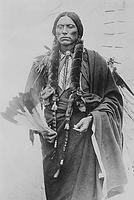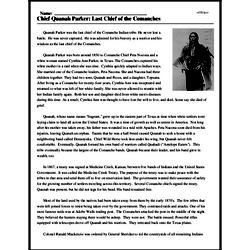Chief Quanah Parker: Last Chief of the Comanches
Quanah Parker was the last chief of the Comanche Indian tribe. He never lost a battle. He was never captured. He was admired for his bravery as a warrior and his wisdom as the last chief of the Comanches.
Quanah Parker was born around 1850 to Comanche Chief Peta Nocona and a white woman named Cynthia Ann Parker, in Texas. The Comanches captured his white mother in a raid when she was nine. Cynthia quickly adapted to Indian ways. She married one of the Comanche leaders, Peta Nacona. She and Nacona had three children together. They had two sons, Quanah and Pecos, and a daughter, Topsana. After living as a Comanche for twenty-four years, Cynthia Ann was recaptured and returned to what was left of her white family. She was never allowed to reunite with her Indian family again. Both her son and daughter died from white men's diseases during this time. As a result, Cynthia Ann was thought to have lost the will to live, and died. Some say she died of grief.
Quanah, whose name means "fragrant," grew up in the eastern part of Texas at time when white settlers were laying claim to land all across the United States. It was a time of growth as well as unrest in America. Not long after his mother was taken away, his father was wounded in a raid with Apaches. Peta Nacona soon died from his injuries, leaving Quanah an orphan. Taunts that he was a half-breed caused Quanah to seek a home with a neighboring band called Destanyuka. Chief Wild Horse took him under his wing, but Quanah never felt comfortable. Eventually, Quanah formed his own band of warriors called Quahadi ("Antelope Eaters"). This tribe eventually became the largest of the Comanche bands. Quanah became their leader, and his band grew in wealth, too.
In 1867, a treaty was signed at Medicine Creek, Kansas, between five bands of Indians and the United States Government. It was called the Medicine Creek Treaty. The purpose of the treaty was to make peace with the tribes in that area and send them off to live on reservation land. The government wanted their assurance of safety for the growing number of settlers traveling across this territory. Several Comanche chiefs signed the treaty. Quanah was present, but he did not sign for his band. His band remained free.




